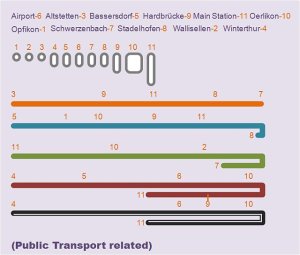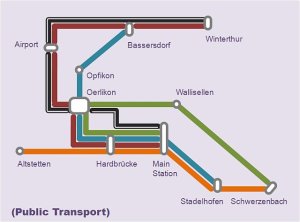Requirements analysis is more than just tidying up, it’s about understanding the complexity of structures. An explanation inspired by the art of Ursus Wehrli:
Is Requirements Analysis just a kind of Tidying Up?
Recently I discussed with some project responsibles, the option to use an issue management system (namely JIRA) for gathering software requirements. The people obviously thought of requirements as a big set of snippets, that have to be collected and ordered, very much like a stamp collection. This seems to be a common misunderstanding of the nature of requirements, which can be elucidated nicely by the art of Ursus Wehli.
Ursus Wehrli is a Swiss comedian and artist, who makes books in which he “tidies up” works of art, for example, sorts the elements of a Kandinsky painting by colour and size, or orders the letters of an alphabet soup alphabetically. (more here: NYT)
Why Tidying Up is not enough
Let’s picture this little Wehrli-forgery here, a unjumbled version of a public transport map:
 It has lines (heavy for city trains, double for long distance), station names and station nodes. So, what is missing? What exactly makes the difference to a complete map? Obviously, it’s the relationships among the map elements that are missing here.
It has lines (heavy for city trains, double for long distance), station names and station nodes. So, what is missing? What exactly makes the difference to a complete map? Obviously, it’s the relationships among the map elements that are missing here.
However, since the elements can still be classified and ordered, there must be some relationships left, determined by the elements’ properties. In this kind of representation they are made explicit, such that it becomes easy to ‘query’ e.g. if there is a station named ‘Opfikon’, or what line is the longest. Thus, simplification by ‘tidying up’ also has certain benefits.
Why Managing Relationships is not enough
 So, why not simply add the relationships to the list, as in (Public Transport related)? It defines the relations name to station node, and station node to line, with station nodes identified by numbers 1 to 11.
So, why not simply add the relationships to the list, as in (Public Transport related)? It defines the relations name to station node, and station node to line, with station nodes identified by numbers 1 to 11.
So, technically all information would be available. However, for humans it’s still too hard to deal with. The relationships are now manageable by the system, but they are not yet expressed in a human-oriented notation. This is why an issue management system (IMS) is not enough to deal with requirements, even if it’s capable of managing relationships. An IMS’ focus is on sorting and grouping things, for example to make a todo-list of requirements, or to support the management of the analysis process.
And why even Visualisation is not enough
 For the typical use of a public transport map, a diagram as (Public Transport) is certainly appropriate, i.e. the human understandability can be accomplished simply by choosing an appropriate notation. And even if the lines and stations become just more, we simply can increase the size of the map. However, if the structure gets more complex, i.e. the elements are ‘closer’ related, diagrams quickly become hard to understand. Visualisation scales well concerning size, but not concerning complexity.
For the typical use of a public transport map, a diagram as (Public Transport) is certainly appropriate, i.e. the human understandability can be accomplished simply by choosing an appropriate notation. And even if the lines and stations become just more, we simply can increase the size of the map. However, if the structure gets more complex, i.e. the elements are ‘closer’ related, diagrams quickly become hard to understand. Visualisation scales well concerning size, but not concerning complexity.
Visualisation of relationships is usually what modelling tools are good at. However, as we have seen the tidy perspective has its advantages, too. Thus, beyond visualising the modelling results (i.e. diagrams), modelling tools should provide ‘tidy’ perspectives (like an IMS), in order support the modelling process. In other words, working out models is more than just documenting them.
Abstraction for Analysis
 If things get more complex – just think of a map with a more complex system of stations and lines (trams, etc) – it might become beneficial to create views on the model, e.g. all available lines from the airport, as in figure (Airport Transport), with connecting lines indicated at each station. Similarly, think of a requirements model of a whole software application, decomposed into data, use-case, state, etc. views/ diagrams. This goes beyond visualisation, this is about abstraction. Thus, as compared to the ‘art of tidying up’, choosing appropriate views on a model, in order to understand its complexity, constitutes the ‘art of abstraction’ (so to say).
If things get more complex – just think of a map with a more complex system of stations and lines (trams, etc) – it might become beneficial to create views on the model, e.g. all available lines from the airport, as in figure (Airport Transport), with connecting lines indicated at each station. Similarly, think of a requirements model of a whole software application, decomposed into data, use-case, state, etc. views/ diagrams. This goes beyond visualisation, this is about abstraction. Thus, as compared to the ‘art of tidying up’, choosing appropriate views on a model, in order to understand its complexity, constitutes the ‘art of abstraction’ (so to say).
By the way, this is also what distinguishes modelling from simple drawing tools. (Just in case, the next project wants to do requirements analysis with VISIO)
So long
|=
PS
Notice that additionally to the relations in (Public Transport related) the diagram (Public Transport) contains the coordinates of the stations. Although, they are only schematic, they provide an approximate geographical location information.
PPS
Ursus Wehrli
Pingback: Modelling the World … | modelpractice